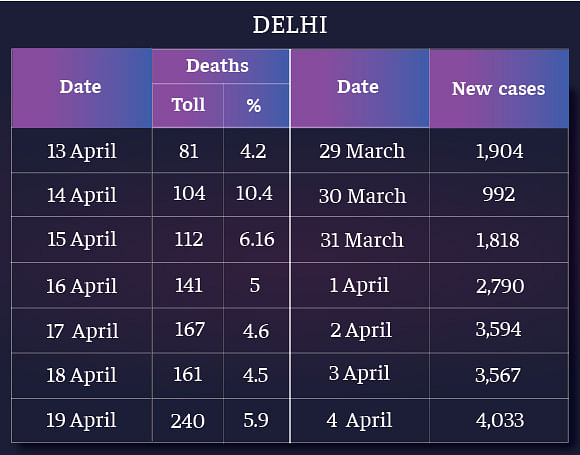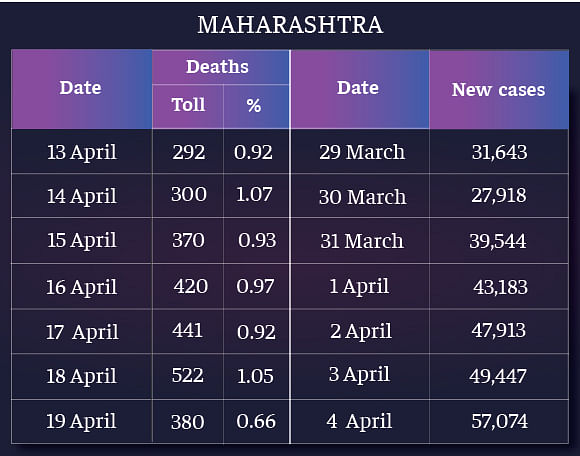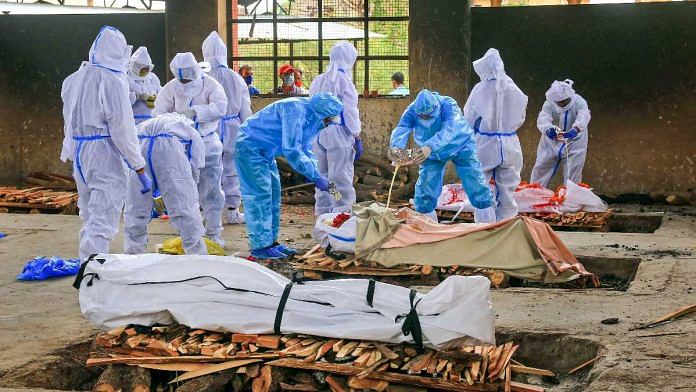New Delhi: Just how bad is India’s second Covid-19 wave?
If one looks at the overall number of deaths and cases, while indeed there is a spike, as a percentage it doesn’t look too daunting.
India’s cumulative case fatality rate, which is the number of deaths calculated as a percentage of the total number of cases reported, is 1.2. However, given the large number of cases reported, the fraction is expectedly low.
To get a more precise understanding of the gravity of the situation, ThePrint takes a look at the number of deaths in India from early this month (when cases starting shooting up) and compared it with the number of cases reported a fortnight ago. This time frame accounts for the average lag of about 15 days between diagnosis and death for a Covid-19 patient in India.
The results are striking. The comparison shows that deaths in India as a percentage of the cases reported a fortnight ago were higher than the cumulative CFR.
We also extended the calculation to Delhi and Maharashtra, the two high-burden regions in the country. While on the one hand Delhi showed a much higher percentage, Maharashtra showed a marginal dip — trends that are indicative of how the health infrastructure is coping.
Also read: More ‘deaths by illness’ in Ahmedabad than Covid as crematoriums see rise in ‘bimari’ funerals
Delhi’s spike, India’s climb
The national capital has been reporting about 25,000 daily cases on an average. Its case fatality rate (CFR) for the entire duration of the pandemic currently stands at 1.47 per cent.
However, when you look at deaths as a percentage of cases reported a fortnight ago, the scenario changes.
The 240 deaths that the national capital reported Tuesday are 5.9 per cent of the 4,033 new cases reported on 4 April. The 161 deaths reported Monday are 4.5 per cent of the 3,567 new cases reported on 3 April. Similarly, the 167 deaths reported Sunday are 4.6 per cent of the 3,594 cases reported on 2 April.
On the day of Holi (29 March), this percentage of deaths went up sharply to 10.4 per cent. This was because the daily numbers almost halved thanks to reduced testing on a festival holiday.

Nationally, the death figures of the last week (13-19 April) when calculated against cases reported a week earlier (29 March-4 April), comes to a percentage ranging between 1.6 and 1.9, which is significantly higher than the cumulative national CFR of 1.2.
India’s total reported deaths of 1,783 Tuesday morning and 1,619 Monday morning are both 1.7 per cent of the 1,03,558 and 93,249 cases that were reported 15 days back on 4 and 3 April respectively. The percentage went up to 1.8 and 1.9 respectively on the Holi weekend of 28 and 29 March when the daily positives were significantly lower.

Also read: North Delhi mayor claims ‘more Covid deaths’ took place than reported by Kejriwal govt
Understanding the trends, Maharashtra’s numbers
Says Dr Giridhara Babu, professor and head, Life Course Epidemiology at the Public Health Foundation of India, the cumulative CFR may not give an indication about the difference in the fatality rates between the first and the second waves of the pandemic.
“As more cases are added and the denominator becomes larger every day, the CFR tends to decrease. The death surge on the other hand has a lag time — this depends on the average time period between diagnosis and death and can vary from place to place,” he added.
“In Karnataka, for example, during the first wave it was 17 days. On the other hand, even if the CFR comes down, the deaths in absolute numbers may be more because of the sheer size of the second wave. It could also change as the hospital infrastructure is more and more stretched.”
Maharashtra, which has seen an explosive and almost exponential rise in cases, bears some good tidings. Over the last week (11-17 April), the deaths as a percentage of cases from a fortnight ago seem to show the first signs of going down marginally.
Tuesday’s toll of 380 was 0.66 per cent of the 57,074 cases reported on 4 April while Monday’s 522 deaths were 1.05 per cent of the 49,447 cases on 3 April. Sunday’s 441 deaths was 0.92 per cent of the 47,913 cases reported on 2 April. Maharashtra’s cumulative CFR is currently 1.65 per cent.

It is a well recognised fact that deaths usually start rising a few days after the rise in cases, said Professor Rajeeb Dasgupta of the Centre of Social Medicine and Community Health at Jawaharlal Nehru University.
“What is crucial to this phase is there are several new variants in circulation and even if one accepts the argument that they are not more fatal than the earlier variants, data to support that claim is not in the public domain,” he explained.
However, certain geographies may end up with more fatalities but the data would take time to reflect that even as crematorium and burial grounds start overflowing, he added.
“The other aspect is that even if it is not fatal, the virus being more infectious would give rise to large numbers of cases that would stretch medical infrastructure. The delay in medical services could end up in fatalities even when the virus itself is not more lethal,” he said talking about other factors that could influence the fatality rate.
Delhi is currently going through a phase in which its medical infrastructure, by Chief Minister Arvind Kejriwal’s own admission, is tottering.
(Edited by Manasa Mohan)
Also read: ‘Where are ambulances, Covid hospitals?’: Family of UP journalist who died without treatment




the demoninator is hard to estimate due to inadequate testing. Seroprevelence studies show 50% of people already have been infected… so only a tiny number of those who are infected actually get tested and have their case added to the denominator
Really insightful analysis…
Maharashtra has lower per capita test rate than even Bihar. UT govt is renowned for extreme incompetency, it is like street urchins have been given power. Please don’t compare Delhi with Maharashtra, although Kejriwal isn’t a good administrator either but not as bad as Thakrey.